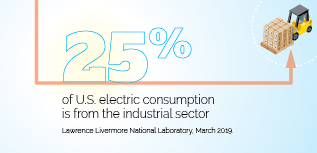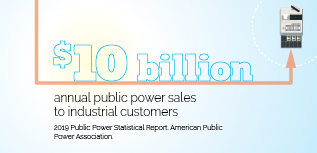Well before electric utilities existed, and before the Industrial Revolution, mills found ways to harness the energy needed to produce an array of food and goods for public consumption. Fast forward to today, and many manufacturers continue to produce their own energy, including generating electricity from combined heat and power systems or other technologies.
Today, utilities have the potential to play a bigger role in the electrification of industry, especially if the relationship allows for a two-way flow of power.
Trends in electricity sales to industry
Shifting industrial processes from combustion fuels to electricity might be the biggest hurdle in electrification. According to the Energy Information Administration, the industrial sector accounts for about a third of the total U.S. energy consumption. But this energy use is not particularly efficient — and slightly more than half is wasted in industrial processes, according to the Lawrence Livermore National Laboratory.
About 12% of industrial energy consumption is from electricity, and that has declined over the past few decades. From 1998 to 2014, the EIA reported that electricity use by manufacturers declined 13%, or 131,134 million kilowatt-hours.
 Since about 2000, retail electricity sales to the industrial sector have similarly declined. The industrial sector’s share of total U.S. electricity retail sales dropped from 30% to 24% from 2000 to 2018. Often, declines and increases in sales to the industrial sector can be tied directly to the strength of the economy.
Since about 2000, retail electricity sales to the industrial sector have similarly declined. The industrial sector’s share of total U.S. electricity retail sales dropped from 30% to 24% from 2000 to 2018. Often, declines and increases in sales to the industrial sector can be tied directly to the strength of the economy.
Part of the decline in sales is because of on-site generation by manufacturers, which is expected to increase. EIA’s 2019 Annual Energy Outlook predicts that manufacturers in bulk chemicals, refining, and paper will increase electricity generation from owned combined heat and power systems by 1.3% per year, from 120 billion kilowatt-hours in 2018 to 181 billion kWh in 2050.
However, outside of these manufacturers, few industries have invested in CHP systems. They will continue to look for ways to operate that are increasingly efficient and meet other objectives.
New possibilities
Industrial electrification does not just promise new loads, but also can bring overall benefits to the energy system, such as ancillary services, demand response, and increased flexible generation that can help support electrification of other sectors without having to invest in new fixed assets.
Possibilities for industrial electrification range from process heating and cooling; to vehicles used for construction, agriculture, and mining; and facility changes.
According to a report from Lawrence Berkeley National Laboratory, “Many of the essential technological elements for industrial electrification exist, but much greater diversity of processes and high levels of process integration make solutions more complex.” The report noted that in some cases, electric process heating has improved productivity and even product quality, such as for metal processing, and has proven cost-effective. The key, noted the report, is for electricity costs to be lower than combustion fuel costs. In cases where a manufacturer uses CHP systems, or has integrated other processes for harnessing energy into its operations, the case for electrification becomes less cost-effective.
Utilities are starting to explore how to make the switch to electric options more attractive for businesses. Missouri River Energy Services, a joint action agency serving public power utilities in the Upper Midwest, rolled out an incentive in summer 2019 for large businesses to get electric forklifts. The incentive is the agency’s first venture into industrial electrification, according to Shannon Murfield, MRES manager of energy services.
Nationwide, public power providers bring in more than $10 billion in annual revenue from industrial customers, which is about 17% of total revenue.

In Seattle, public power utility Seattle City Light is starting talks with the Port of Seattle about how it can electrify its operations in a long-term strategy. According to Emeka Anyanwu, energy innovation and resources officer at City Light, this could mean everything from putting ships in shore power to using electric forklifts, cranes, and trucks.
Although details of the move are still in development, Anyanwu noted that the nature of the discussion shows a changing relationship between the utility and key account customers.
“Our general premise is that we want to support and facilitate whatever goals our industrial customers have, as aggressive [as] they may be,” said Anyanwu. “We want to try to be in lockstep with them, to move as fast as they want to move. That means very rapidly beginning to transform our approach.”
In addition to the port, King County Metro, Seattle’s transit agency, has begun talks with City Light about transitioning to a zero-emissions fleet by 2040. The agency has tested some initial use of electric trolleys and buses, but moving the whole system to electric will require both the agency and City Light to determine how such a move could work at scale.
Exploring this strategy collectively has helped Seattle look at how to prepare for electrification of heavy-duty vehicles.
“The advent of large, heavy-duty electrification is not only a revenue opportunity, but also a sea change in the kind of loads those represent,” said Anyanwu, explaining that the load shape could be quite different from what the utility has dealt with in the past, because of the intermittency of charging such vehicles.
“What we think we know at this point is that those new loads are going to have an impact on our distribution and transmission systems that is unprecedented,” he added. “We do not fully know exactly what kind of changes that will require of us. We see ourselves adjusting our operations, our procedures, maybe our engineering standards to accommodate new loads.”
Another area for potential electrification is indoor food production, which is expected to grow as the population expands and arable land gets more constrained. A limitation on the growth of such facilities is the intensive energy they can require, especially from lighting. MRES is starting a project, with funding from the American Public Power Association’s Demonstration of Energy and Efficiency Developments program, on indoor food production as a source of efficient commercial and industrial load growth. The project will monitor a specialized 400-square-foot container, located at South Dakota State University, to learn more about power use — among other factors — related to growing vegetables indoors. Produce harvested will be donated to the nonprofit Children’s Museum of South Dakota and agencies serving those in need.
Changing partnerships
In Nebraska, rethinking industrial energy use has led to some unique partnerships. The Nebraska Public Power District is planning on putting the byproduct of an industrial customer, Monolith Materials, to use in generation. NPPD is in the process of changing its Sheldon Unit 2 plant near Hallam, Nebraska, from coal to hydrogen. The hydrogen will flow through a pipeline from a facility Monolith is building across the road from the generating unit. According to John Swanson, NPPD’s generation strategies manager, the hydrogen produced from Monolith’s facility when fully built out, which NPPD has agreed to purchase, is expected to surpass what the plant will need for generation. NPPD has also been exploring the business case for making methanol from the excess hydrogen.
Anyanwu said that with any large commercial or industrial customer looking at electrification, he is hoping for the utility to be involved early in the planning process.
“We want to be that group of trusted advisors and contributors that helps collaborate with them … to help them make choices, identify options and, ultimately, partner to deliver the best outcomes.”
“We’re not only providing industrial customers the opportunity to make this transition as aggressively as they want to,” he said, “but we want to make sure that the people who work there, or live in and around their facilities, benefit from the transition they are making.”
Anyanwu said that major electrification initiatives will “be a very complex, technical, economic, and social question” for utilities, and that any approach should avoid unintended negative outcomes for any part of the community.
What’s best for the community
In industry and manufacturing, changes in technology often bring up the question of how the workforce will be affected.
The Electric Power Research Institute’s National Electrification Assessment noted that in addition to the potential economic case for industrial electrification in certain processes, electric industrial technologies have the potential to improve workplace safety and improve indoor air quality for workers, especially from electrifying “non-road vehicles.”
“A lot of the conversations around electrification seem to suggest that there are opportunities for new jobs,” said Anyanwu. For example, with electrification of the transit agency, the city might be able to attract new customers, such as bus manufacturers, to provide the technology needed. Anyanwu said the utility is working with the mayor’s office and other city departments to promote economic development that aligns with the city’s future plans.
“Being locally owned, being part of and embedded in the city of Seattle, means that we have particular insights into the overall combination of factors that will lead to the best outcomes for electrification,” said Anyanwu. “Being an organization whose primary and only purpose is to provide this service … we can be completely focused on what works for our community.”

